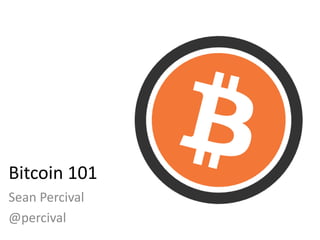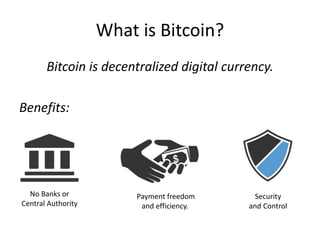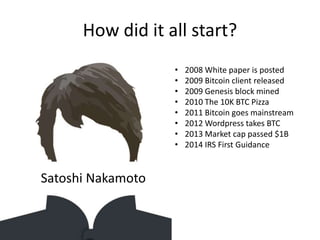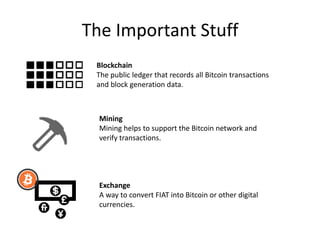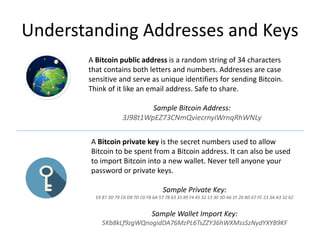Bitcoin 101 Intro Presentation
- 2. What is Bitcoin? Bitcoin is decentralized digital currency. Benefits: No Banks or Central Authority Security and Control Payment freedom and efficiency.
- 3. How did it all start? Satoshi Nakamoto ŌĆó 2008 White paper is posted ŌĆó 2009 Bitcoin client released ŌĆó 2009 Genesis block mined ŌĆó 2010 The 10K BTC Pizza ŌĆó 2011 Bitcoin goes mainstream ŌĆó 2012 Wordpress takes BTC ŌĆó 2013 Market cap passed $1B ŌĆó 2014 IRS First Guidance
- 4. USD Value Over Time Peaked ~$1150
- 5. The Important Stuff Blockchain The public ledger that records all Bitcoin transactions and block generation data. Mining Mining helps to support the Bitcoin network and verify transactions. Exchange A way to convert FIAT into Bitcoin or other digital currencies.
- 6. Understanding Addresses and Keys A Bitcoin public address is a random string of 34 characters that contains both letters and numbers. Addresses are case sensitive and serve as unique identifiers for sending Bitcoin. Think of it like an email address. Safe to share. Sample Bitcoin Address: 3J98t1WpEZ73CNmQviecrnyiWrnqRhWNLy A Bitcoin private key is the secret numbers used to allow Bitcoin to be spent from a Bitcoin address. It can also be used to import Bitcoin into a new wallet. Never tell anyone your password or private keys. Sample Private Key: E9 87 3D 79 C6 D8 7D C0 FB 6A 57 78 63 33 89 F4 45 32 13 30 3D A6 1F 20 BD 67 FC 23 3A A3 32 62 Sample Wallet Import Key: 5Kb8kLf9zgWQnogidDA76MzPL6TsZZY36hWXMssSzNydYXYB9KF
- 7. Tools of the Trade Wallets News and Market Payment Processing Using Bitcoin

